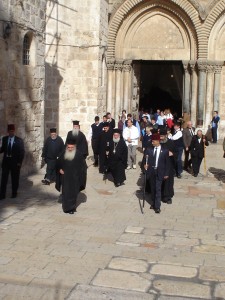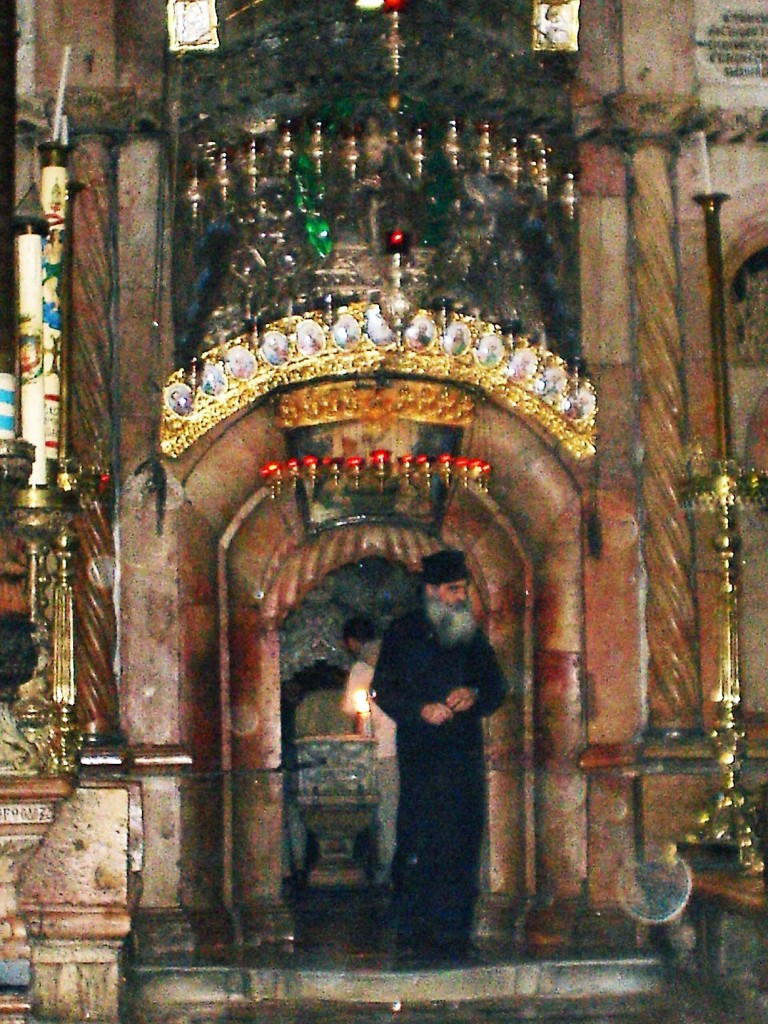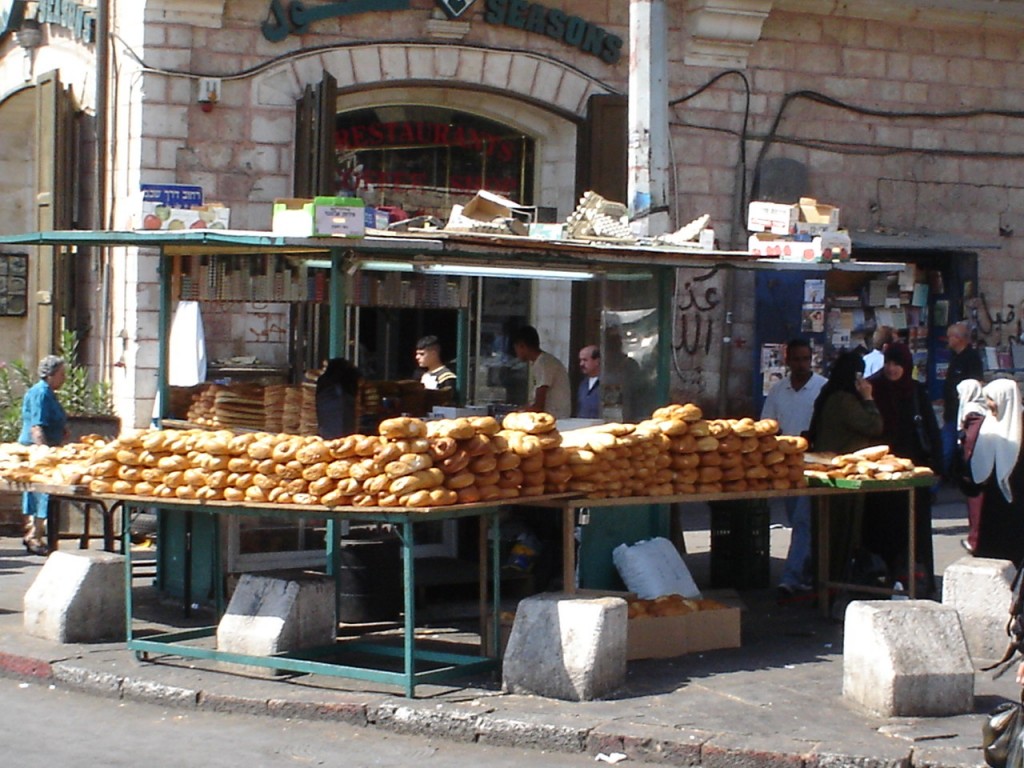Today Katie and I finally made it to church. We actually tried to go a couple weeks ago. We found the building but we couldn’t find the service in the building. What?! How can you not find a service in a church building? You’d think something like that would be obvious, wouldn’t you? It would be in nearly any usual church anywhere else in the world. The problem is that the Church of the Holy Sepulcher (the CHS), is very, very unusual.
The unusualness of our church experience began before we were anywhere near the building itself. Sunday is the first day of the week. Most calendars make that plain. The U.S. work week begins on Monday, the second day of the week. Most churchgoers attend on Sunday, the first day. In Israel, the holy day is the Sabbath, the last day of the week (Saturday), making Sunday a normal work and school day. My point is that our habit of cutting travel time to church close, knowing the route there is mostly vacant streets won’t work here. I learned we needed to treat it like a normal work day, leaving earlier than you’d think necessary to allow for rush hour traffic.
We parked outside the Old City and entered via Jaffa Gate, one of the major entrances into the old city, and made our way down the narrow, stair-stepped, shop-lined lanes to the CHS. The actual main entrance into the church is on the side of the building. I walk in, impressed equally by the large scale of the place, the massive stones in walls and pillars, the soaring ceiling, the many nooks, crannies and passageways heading in different directions, as well as the wear inflicted upon it over the centuries to which smoothed flagstones, indented stone stairways, and besooted celings bear mute witness.
This is not our first visit to these holy precincts. The first weekend after we arrived we made our way here and, following a great multitude of earlier pilgrims’ footprints, went to the Tomb to actually see, touch, and kiss the stone where Jesus was placed (in reality we saw the marble slab placed over that other original one, but the point and feel and effect, I suspect, are the same). The entry into the tomb itself is managed by a focused fellow I call The Guard Monk. The GM controls the number of people who enter at a time (both tomb and antechamber are quite small), as well as prevents the immodestly dressed from entering. That first time I was ever there, I saw the GM hold up his hand before the sleeveless bloused, shorts wearing woman in front of us, and with a few mid-air flicks of his finger like he was trying to pare away her immodesty, indicated that she could not enter. On another recent visit I saw two Americans…I knew where they were from without even having to hear their accent… each with an Arab headscarf like what Yasser Arafat and about 10 million other Arab men wear, unfolded and wrapped around their waists, covering their exposed, Bermuda shorted legs. They looked completely goofy in their Palestinian sarongs but the GM let them in all the same. I find myself admiring the GM and suspect this assignment gives him many chances to cultivate a monastic patience.
The sanctuary where we attended liturgy (worship service) today is the main one in that expansive edifice but not by any means the only one. Six groups share use of the CHS: Greek Orthodox, Armenian Orthodox, Coptic, Latin (Roman Catholic, represented here by the Franciscans) and Assyrian. Their comings and goings, timings and schedules, and general building use are governed by a Status Quo council. The building actually contains at least two monasteries that I know of (Franciscans and Ethiopians), as well as different offices and entire sections, wings, sanctuaries and altars used by each group, sized and placed according to prominence or possibly number of adherents. I’m glad for at least this level of cooperation but alas, any given week has only one Sunday and naturally each of the various communities want to conduct services on that day. And though the various sanctuaries are separated from each other, the sounds of diverse choirs, chantings, and languages echo throughout the building, reverberating off the ancient stone walls, mixing with each other to form a holy cacophony of praise to God. I stood in the Greek service today amused by the conflicting strains of service music floating around, and amazed by the mess God will need to sort through on Judgment Day. On the other hand, even in the midst of the strangeness of the total event and the diverse multiplicity of services, I was comforted by the familiarity of the Greek rite, the liturgy we would experience in any Orthodox church anywhere in the world. In terms of our fellow attendees, there were more monks than one usually sees in a typical church, but then again Jerusalem is home to many monasteries. And I think black robed, round hatted, long bearded Greek monks add a touch of solemnity and holiness.
We actually were with a local friend at church, a Greek dentist named Nick whose children, the fifth generation in his family to be born in Jerusalem, are friends of Katie’s from school. After church he showed us around the CHS, pointing out some things the tour guide missed. We went upstairs to the Armenian service and observed the solemnities for a few moments. Their monks wear a slightly different sort of attire which includes a black hood with a pointed top. As we walked out of the church, he suggested we have some breakfast, a humble affair in Jerusalem. We agreed and followed him to several local shops I would never have noticed on my own, holes in the wall where the prices were low and the quality, high. For 50 cents a piece he bought three loaves of kyke, a long oval of bread about 18 inches from end to end and the diameter of a large bratwurst, studded all over with sesame seeds and cooked golden brown. This ubiquitous baked treat is wonderful and only made in East Jerusalem. He also picked up baked eggs, cooked to a smokey doneness in the same oven with the kyke, and then at a small restaurant purchased some wonderful humus to go. It was a pleasure sharing these fresh, satisfying foods over coffee, with him and his two children back at their smallish but nice old city apartment.
One of the best parts of this life is when I can experience the sublime and juxtapose it with the common. I enjoy being in the Church of the Holy Sepulchre as well as the kitchens and living rooms of local friends like Nick and his family.




One Response to Going to Church at the Holy Sepulcher